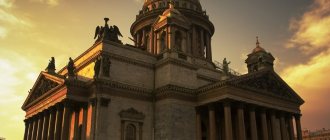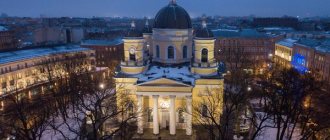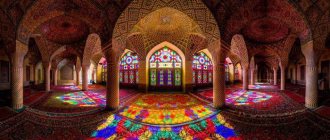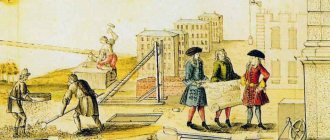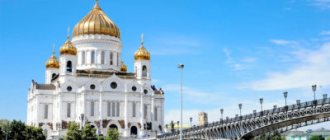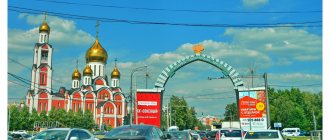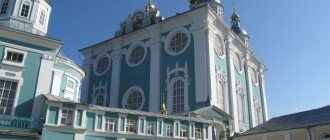The XIX Ecumenical Council of Trent of 1545-1563 became one of the most important milestones in Catholicism. Most of the accepted dogmas remain relevant after half a millennium. The High Assembly of the spiritual leaders of the Catholic Church met at the height of the Reformation, when the inhabitants of northern Europe, dissatisfied with the abuses and luxurious life of the clergy, refused to recognize the authority of the Pope. The Council of Trent and the most important results of its work became a decisive “offensive” against the reformers, marking a milestone in the Counter-Reformation of the 16th century.
Spiritual background to the conflict
By the end of the 15th century, the Catholic Church concentrated many lands in its hands and accumulated great wealth. In Europe, church tithes were common - the collection of a tenth of the profit from the harvest or cash income. The church lived magnificently at a time when a significant part of the believers was poor. This circumstance undermined the foundations of faith and the authority of the church. In addition, the popes widely expanded the trade in indulgences - special letters “for the remission of sins.” For a certain amount of indulgence, a person, regardless of the severity of the offenses, was freed from any sin. This sale caused discontent among believers. The center of the Reformation was Germany, which was then fragmented and resembled a “patchwork quilt.” Against such an unfavorable background, it was decided to convene the Council of Trent.
Humanism caused significant damage to the authority of the Catholic Church. Its leader was Erasmus of Rotterdam. In the pamphlet “In Praise of Stupidity,” the humanist sharply condemned the shortcomings and ignorance of the clergy. Another figure of German humanism was Ulrich von Hutten, who considered papal Rome to be opposed to the unification of Germany. It should be added that the believers were also irritated by the fact that the language of worship was Latin, which ordinary parishioners did not understand.
Reformation
The Reformation became a global challenge to the foundations of the Catholic Church. For the most part, the decisions of the Council of Trent were directed against the Reformation. The original idea was to hold a joint meeting of the Council under the chairmanship of the Pope and the leaders of the Reformation. However, a dialogue, rather a scholastic dispute, did not work out.
On October 31, 1517, Martin Luther nailed the “95 Theses” to the door of his church in Wittenberg, sharply condemning the trade in indulgences. In a short time, tens of thousands of people became supporters of Luther's ideas. In 1520 the Pope issued a bull excommunicating the monk from the church. Luther burned it publicly, which meant a final break with Rome. Martin Luther didn't object to the church, he wanted it to be simpler. The postulates of the reformers were clear to everyone:
- Priests could marry, wear ordinary clothes, and must obey laws common to all.
- The Lutheran Church abandoned icons and sculptures of Christ and the Mother of God.
- The Bible is the only source of faith for Christians.
Part 2
In the mid-11th century there followed a complete break between the Eastern and Western Churches. Instead of the previous peaceful relations, hostile ones were established. With their cruelty and desecration of Greek shrines during the Crusades, the Latins even made these relations hostile. The Greeks hated the Latins as heretics and their oppressors. The Latins, in turn, hated the Greeks as schismatics (as they called them) and as double-minded and treacherous people. Hostile feelings often led both to bloody clashes. But, despite this, very often attempts were made to unite churches. There were special reasons for seeking ecclesiastical union. The popes, even after the division of the churches, did not lose hope of subjugating the Greek-Eastern Church and, for this purpose, sought to restore communion. But they understood by communion not a union between churches, but the subordination of the Eastern Church to the Western, or, what is the same, to the pope. The Greeks, for their part, according to political calculations, also wanted to unite the churches. The political situation of Byzantium in the era described was too difficult. The decrepit empire, when attacked by the Turks and the Crusaders, fell into decay. Counting on the assistance of the popes, who had great influence on the course of political affairs throughout Europe, in order to protect the empire from enemies and prevent its fall, Byzantium sought an alliance with Rome. And since the popes could not be won over in any way except by expressing a desire to unite the churches (with the subordination of the Eastern - Western), the Byzantine government in all negotiations put the issue of this union to the fore. But this prudence alone already spoke of the fragility of the attempts. The negotiations lacked sincerity; the Latins and Greeks, under the pretext of uniting churches, pursued other goals. Therefore, when these goals were achieved or not by one side, the question of union was relegated to the background. The fragility of attempts to unite churches was largely due to the fact that they were not universal, at least in the east. On the part of the Greeks, the emperors worked for reunification, but the church hierarchy and the people were always against the union, since they saw in it the subordination of the church to the popes. Of the many unsuccessful attempts at unification, two are especially remarkable, brought to completion by all kinds of tricks and violence and which had sad consequences for the Eastern Church. These are the so-called unions - Lyon (1274) and Florentine (1439).
In 1261, the Latin Empire in Constantinople fell. The Nicaean emperor Michael VIII Palaiologos (1259–82), with the assistance of the Genoese, took Constantinople from the Latins and restored the Byzantine Empire. But the position of the empire and its sovereign was very difficult. The last Latin emperor, Baldwin II, after the fall of the empire, went west and begged the pope and the sovereigns to help him regain the throne. Pope Urban IV, who had also lost Constantinople to the Greeks, took Baldwin's side and excommunicated the Genoese for their alliance with Palaiologos and began calling for a new crusade against Constantinople. Baldwin's father-in-law, Charles of Anjou, who had then taken possession of Naples and Sicily, really began to prepare for war with Palaeologus. At the same time, the Bulgarians and the Latin princes of Achaia and Peloponnese, who had remained independent after the fall of the Latin Empire, began to advance on Constantinople. Unrest within the empire completed the confusion of affairs. Michael Paleologus ascended the throne illegally. After death (in 1259). Nicene Emperor Theodore II Laskaris, the throne was to be taken by his young son John. But Palaeologus, by cunning and violence, removed John from the throne, and a little later, even blinded him. Such an atrocity turned Patriarch Arseny and the people against him. Although Paleologus deposed and exiled Arsenius, after he excommunicated him from the Church, discontent against him did not weaken.
The new Patriarch Herman, due to popular unrest, had to leave the department. When then, the royal confessor Joseph was installed as patriarch and lifted the excommunication from Palaeologus, many of the clergy and laity reached such indignation that they did not recognize Joseph as patriarch and formed a strong party of supporters of Arsenius. The people even stood up for the unfortunate John Laskaris. In the Nicaea region, a blind young man was found, whom the inhabitants recognized as John Laskaris and proclaimed their king. Palaeologus had to remove the new contender to the throne by force of arms. Finding himself in such difficult circumstances, the cunning Mikhail Paleologus hoped that he could stop the attack of Charles of Anjou with the help of the pope, and cope with the rest of the enemies on his own. To this end, immediately after the capture of Constantinople, he entered into relations with Pope Urban, and then Clement IV; sent several embassies to them with rich gifts and a proposal to unite churches. However, negotiations with these popes did not lead to any positive results, mainly because the popes did not trust Palaiologos. Only since 1271, when Pope Gregory X, who strongly desired a union with the subordination of the Eastern Church to the Western, ascended the throne, did negotiations become more successful. Gregory sent a letter in which he praised Palaiologos for his intention to submit to the apostolic throne and invited him to a council in Lyon in 1274 to finally resolve the issue of unification. Moreover, among the conditions for union, the pope set the acceptance by the Greeks of the Latin Creed with the addition of filioque and recognition of the primacy of the pope. The paleologist decided to unite the churches on the proposed terms, as he was afraid of the intrigues of Charles of Anjou. The Pope's letter in Constantinople was examined carefully.
The Greek clergy, led by Patriarch Joseph, previously submissive to the emperor, was against the proposed union. Paleologus summoned the patriarch and bishops to himself and began to persuade them to agree to unite with the Roman Church, saying that the pope’s conditions were acceptable: remembering the pope at services was not at all disgusting to the Eastern Church, recognizing him as a brother and even the first was not humiliating. As for the right of appeal to the pope, it will not be applied, since, in “doubtful cases, hardly anyone would want to sail overseas for this.” The emperor did not talk about reading the Symbol with the addition of filioque. In general, he presented the union as a matter of a political nature. The patriarch and bishops, despite these convictions, still did not agree to the union. The Patriarch commissioned his chartophylax, the scholar John Veccus, to tell the truth that the Latins were secret heretics. This irritated the emperor, and he imprisoned Vek. However, the emperor managed to attract Vek to his side, and he became an ardent supporter of the union. Meanwhile, it was necessary to release the embassy and give an answer to the pope. Palaiologos, who had already decided on union, wrote to the pope that he would send representatives from the Eastern Church to the Lyon Council. The only thing that made it difficult for the emperor was the opposition of the head of the Greek church, Patriarch Joseph, who had already managed to send out a district message to the bishops against uniting with the Latins. But the emperor found a way out - he suggested that Joseph temporarily retire to a monastery, with the understanding that if the union failed, he would again take his see, but if it succeeded, he would completely renounce the patriarchate. Joseph, willy-nilly, agreed.
Palaeologus, with the bishops who agreed with him, prepared a letter from the Greek clergy to the pope and sent an embassy to the Lyon Cathedral. Among the ambassadors were the former Patriarch Herman and the great logothete George Acropolis. They arrived in Lyon when the pope and the Latin prelates had already gathered there. The Pope received the ambassadors kindly. The fourth meeting of the council was devoted to the unification of the churches, but the matter was set up in such a way that no discussions about the differences between the churches were allowed. First of all, the pope declared to the council that the Greeks voluntarily obey the Roman Church. Then the letters of Palaiologos and his son Andronikos, and a letter from the Greek clergy were read. Both in the letters and in the charter, complete submission to the pope was expressed, only the emperor asked that the Greeks leave the Symbol without a filioque. Then the great logothete George Acropolis took an oath on behalf of Michael Palaiologos that he renounced any division with the Roman Church and promised to inviolably preserve its confession of faith and recognize its primacy. The same oath was given by spiritual envoys on behalf of the Greek people. In conclusion, they sang “We praise God to you” and the Creed with the addition of the Son. Thus, a union took place between the Eastern and Western Churches. The compliant Greek ambassadors received rich gifts as a reward and returned to Constantinople. An embassy from the pope also arrived with them. Palaeologus was very pleased with the outcome of the matter at the Council of Lyon, since following the approval of the union, the pope ordered that peace be concluded between him and Charles of Anjou. All that remained was to introduce the union into the Greek Church. The paleologist used all means, not excluding violent ones, to persuade the Greek clergy to union. When the papal ambassadors arrived and brought the union, he declared the division of churches non-existent and demanded that everyone recognize this matter as accomplished. Patriarch Joseph was declared deposed and John Vekk was elevated to his place. It was ordered to remember Gregory X at divine services as the supreme bishop of the Apostolic Church and the ecumenical pope.” But the cause of union was too fragile. Only the emperor and a party of his followers accepted it. All Greeks, both clergy and laity, who did not want union, did not want to have any communication with the Roman Church.
The Orthodox began to curse the Uniates; they did not want to have any relations with them; they even considered it desecration to touch or talk to them. The paleologist wanted to win over the Orthodox to his side with affection. When this failed, he took violent measures: exiles, imprisonment, blinding, cutting off hands, tearing of nostrils, and the like began. He did not even spare his relatives. At the same time, Vekk tried to attract the people to the union with his messages and writings. But neither the violent measures of the emperor nor the writings of Veccus brought any benefit - the Greeks did not accept the union. Meanwhile, in Rome they learned that there was no union in the Greek Church. Pope Gregory X and his followers had not yet disturbed Palaiologos. But Pope Nicholas III wanted to see the union in reality. For this purpose, he sent his legates to Constantinople, whom he instructed to insist on the full introduction of the union, with the adoption of the Latin Symbol and subordination to the pope. Palaiologos' position was critical. But with the usual cunning he managed to get out of the difficulty. The ambassadors were received magnificently, they were shown respect everywhere, the emperor assured them of his devotion to the union and the pope, ordered a letter to be drawn up from the Greek clergy, which set out the Roman teaching, allegedly accepted by the Greek Church (the signatures of the bishops in the letter were forged), showed them the prisons where opponents of the union were kept. Finally, he even sent two opponents of the union to the pope for trial, whom, however, the pope returned without punishment. With such a cunning policy, Paleologus calmed Pope Nicholas, so that he entered into a secret alliance with him against Charles of Anjou. In 1281, Martin IV ascended the papal throne. This pope did not succumb to the deception of Palaiologos. Knowing that the union does not exist in the Greek Church, he contemptuously sent away the ambassadors of Palaiologos, and excommunicated him. The paleologist, irritated by this act of the pope, forbade commemorating him during divine services, but still did not formally destroy the union. Charles of Anjou, no longer bound by the pope's ban, began a war with Paleologus, but he, thanks to his cunning policy, defeated him. For the defeat of Charles, the pope once again excommunicated Palaiologos in 1282. But Palaeologus died that same year. With his death, the Union of Lyons ended. His son and successor, Andronikos II (1283–1328), decisively took the side of the Orthodox. In 1283, a council was convened in Constantinople, at which the main Roman error was condemned - the doctrine of the procession of the Holy Spirit and from the Son. At the same time, the followers of the Uniates were also tried, and first of all Vekko, who was deposed and exiled to prison. The churches in which Uniate services were held were re-consecrated. A few decades later, there were no traces of the Union of Lyons left in the east.
The Union of Florence had a similar outcome. By the beginning of the 15th century. The Byzantine Empire was finally conquered by the Ottoman Turks. The government, as before, sought help in the West and, mainly, from the popes. For this purpose, the Greek emperors of the last times of the empire often personally traveled to the west, such as John V Palaiologos (1341–91). and Manuel II Palaiologos (1391–1425). But the West did not provide any help. Manuel's successor, John VI Palaiologos (1425–48), foreseeing the imminent and inevitable fall of the empire under the arms of the Turks, decided to try the last resort to save it - under the pretext of uniting churches, to subordinate the Eastern Church to the pope and for this to receive help from Western sovereigns. To do this, he began negotiations with Pope Eugene IV. The pope agreed to the emperor's proposal. It was agreed to form an ecumenical council of representatives of the Greek and Latin churches and at it resolve the issue of unification. They also decided to invite Western sovereigns to the council in order to convince them to provide assistance to the Byzantine Empire. After long negotiations about the location of the cathedral, they finally appointed it in Ferrara. The Pope assumed the expenses of travel and maintenance during the Council of Greek Bishops. At the end of 1437, Emperor John Palaiologos, Patriarch Joseph, representatives from the eastern patriarchates and several Greek bishops went to Ferrara. Even the Russian Metropolitan Isidore, a Greek by birth, who had long ago agreed to the union, attended the council. Immediately upon arriving in Ferrara, the Greek hierarchs suffered several insults from the Latins. Thus, the pope demanded that Patriarch Joseph, upon meeting him, kiss his shoe, according to Latin custom. Only after Joseph's decisive refusal did he abandon his demand. Before the opening of the cathedral, meetings of Greek and Latin fathers took place about the difference in religion. At these meetings, the Greeks were especially distinguished by Mark, Metropolitan of Ephesus (also the representative of the Patriarch of Jerusalem), and Bessarion, Metropolitan of Nicaea. Mark of Ephesus made no concessions in favor of Latin teaching. Finally, 8 Oct. 1438, the pope, by agreement with the emperor, opened the cathedral, although no one from the Western sovereigns came.
At the council, the main controversial issue was the Latin teaching about the procession of the Holy Spirit and from the Son. The Greek fathers raised this issue on a canonical basis and argued that the Latin Church acted wrongly when it introduced the filioque into the Nicene symbol, contrary to the positive prohibition of the Third Ecumenical Council to make additions to the symbol. The Latins, on the contrary, argued that the Latin Church did not introduce a new teaching, but only revealed that which was contained in the creed. 15 meetings were held in this type of dispute. The Greek fathers, especially Mark of Ephesus, remained unyielding as before. For this, dad began to constrain them with their contents. Meanwhile, plague appeared in Ferrara. Under this pretext, the pope moved the cathedral to Florence in 1439. Here the debate on the same subject continued. Only the Latins transferred the question of the filioque from canonical to dogmatic soil. They argued that their teaching in itself was correct and confirmed this with passages from St. Scriptures and ancient patristic writings, with arbitrary interpretation. The Greek fathers objected to this that the Latin teaching about the procession of the Holy Spirit and from the Son cannot be deduced from the passages cited. The emperor was extremely unpleasant at the intransigence of the Greek fathers. He began to convince them to come to an agreement with the Latins. The former opponent, Vissarion of Nicea, inclined to agree, recognizing that the Latin expression is from the Son
corresponds to the Greek -
through the Son
.
But Mark of Ephesus was against this and called the Latins heretics. The paleologist, acting in favor of unification, with his adherents compiled the following statement of the doctrine of the Holy Spirit: the Greeks, recognizing that the Holy Spirit comes from the Father, do not deny that He also comes from the Son. But Mark of Ephesus and others rejected this presentation. The Latins, meanwhile, demanded the full acceptance of their teaching about the Holy Spirit. The emperor began to force the Greek fathers to fulfill this demand with persuasion and threats. Willy-nilly, the Greek fathers had to agree with the emperor’s demand, and at the same time recognize the primacy of the pope. There were no major disputes regarding ritual differences: the Latins agreed to accept the same rituals of the Latin and Greek churches. When the act of union of churches was drawn up, it set forth the Latin doctrine of the Holy Spirit and the primacy of the pope. This act was signed by all Greek bishops, except Mark of Ephesus
and Patriarch Joseph, the latter died at that time.
Dad, not seeing Mark’s signature, said frankly: we didn’t do anything.
Still, the act was solemnly read in the cathedral church in Latin and Greek, and as a sign of communication and unity, the Greeks and Latins hugged and kissed. The pope, to celebrate, gave the Greeks ships, and they went home. Upon returning to Constantinople, Paleologus became convinced of how fragile the forced union of churches, forced by circumstances, was. The same Greek bishops who agreed to the union, after arriving home, refused it, pretending that they were forced there to agree to a union with the Latins. The Greek clergy and people, having learned about the union, were indignant and considered the Uniates to be heretics. All defenders of Orthodoxy grouped around Mark of Ephesus. The Patriarchs of Alexandria, Antioch and Jerusalem were also against the union. They held a council in Jerusalem in 1443, at which they pronounced excommunication on all adherents of the union. Although Palaeologus elevated one after another adherents of the union to the patriarchal throne (Metrophanes of Cyzicus and Gregory Mummu, his former confessor), the union made little progress. And the emperor himself, having not received the expected help from the west, was cold towards the cause of union. He died in 1448. Under his successor, shortly before the fall of Constantinople, the Eastern patriarchs once again condemned the union at a council in Constantinople in 1450. Here they deposed the Uniate Gregory Mammu and elevated the Orthodox Athanasius to the patriarchal throne. Mamma fled that same year to Rome. In 1452, when the Turkish danger began to threaten Constantinople, Emperor Constantine again tearfully begged the pope for help. The latter previously sent Cardinal Isidore, the former Russian metropolitan, to Constantinople to approve the union. On November 12, 1452, Isidore arrived there and prepared the people for unification. But he found a strong accuser in the person of Gennady Scholarius, the future patriarch. Still, Isidore performed the liturgy in the St. Sophia Cathedral, commemorating the pope and the deposed Patriarch Gregory. Apart from the emperor and his courtiers, few took part in this. Crowds of the lower clergy, monks and people rushed to the monastery of Pandocrator and asked the monk Gennady who lived there: what to do? Gennady did not show himself to the people, but hung a piece of paper at the window of his cell with the words:
“Unfortunate Romans. Why are you mistaken, losing hope in God and placing your trust in the Franks? Why do you want to destroy your Orthodoxy together with the city that has a mouth? God have mercy on me. I testify before Your face that I am innocent of this crime. And you, unfortunate ones, look at what you want to do when you are threatened with captivity? You dare to pervert the faith of your fathers and submit to untruth. I will never leave you, dear Orthodoxy, and I will not depart from you, sacred tradition, as long as my soul dwells in this body.”
The people cursed the union
, stopped visiting the St. Sophia Temple and, according to the Greek writer Ducas, “if an angel had appeared from heaven and promised the Greeks salvation under the condition of a union with the Latins, they would still have rejected it.” When Constantinople was captured by the Turks in 1453, there was no longer time to think about the Union of Florence. At the initiative of even Sultan Mohammed, Gennady II Scholarius (1453–60) was chosen as patriarch.
The Birth of Protestantism
Emperor Charles V decided to intervene in the matter. In 1521 Luther arrived at the Reichstag in the city of Worms. There he was asked to renounce his views, but Luther refused. Indignant, the emperor left the meeting. On his way home, Luther was attacked, but the Elector of Saxony, Frederick the Wise, saved him by hiding him in his castle. The absence of Martin Luther did not stop the Reformation.
In 1529, Emperor Charles V demanded that the apostates observe exclusively the Catholic religion on the territory of the Holy Roman Empire (essentially Germany). But 5 principalities, with the support of 14 cities, expressed their protest. From that moment on, Catholics began to call supporters of the Reformation Protestants.
Attack on the Reformation
Throughout its long history, the Catholic Church has never known such a deep shock as the Reformation. With the support of the rulers of Catholic countries, Papal Rome began an active fight against the “Protestant heresy.” The system of measures aimed at stopping and eradicating reform ideas and movements was called Counter-Reformation. The trigger for these events was the Council of Trent in 1545.
The beginning of the offensive against the Reformation was marked by the revival of the medieval Inquisition, in the centers of which hundreds of “Protestant heretics” died. The inquisitors took control of book publishing. Without their permission, not a single work could be published, and “harmful” literature was included in a special “index of prohibited books” and was subject to burning.
Catholic reform
The Reformation split the Catholic world in half, but in the mid-16th century, Europeans hoped that the situation could still be corrected. It is only necessary that in search of reconciliation both sides take a step towards each other. Not only ordinary believers, but also some cardinals and bishops thought so. From their midst, the voices of those calling on the Holy See to carry out church reform sounded more and more insistently.
The popes hesitated for a long time before agreeing to the transformation. Finally, in 1545, Pope Paul III convened an Ecumenical Council. The location of the Council of Trent corresponds to the city of Trento (Italy). It took place intermittently until 1563, that is, for 18 years.
Cathedral of Trent. On March 15, 1545, the Ecumenical Council opened in the city of Trento (in Latin
On March 15, 1545, the Ecumenical Council opened in the city of Trento (Latin: Trident), called the Council of Trent. The papal bull dedicated to the opening of the council outlined its tasks: defining the Catholic faith and reforming the church. The need for systematization and unification of Catholic teaching was also postulated. The purpose of convening this council was to raise the authority of Catholicism and strengthen it. The representatives of the church who gathered there were divided into two parties: the irreconcilable papal and the compromising imperial. The papal party condemned dogma and erroneous, heretical teachings. They rejected any possibility of negotiations with the Protestants on equal terms. The Imperial Party wanted to consider the reasons for heretical teachings, the reasons for the demoralization of the clergy. They wanted to allow secular people to be allowed to discuss many important issues and to negotiate with Protestants. The imperial party was very weak, and Paul III managed to impose his program on the council. At the same time, the Holy Roman Emperor Charles V won several victories in the war with the Protestant Electors. This could strengthen the position of the imperial party at the council and force the papal party to make concessions. Paul III did not want such a turn of events. To prevent this situation, he decided to deprive Charles V of his military assistance and recalled his troops from Germany and stopped financial support for the imperial troops. The meeting place of the council was moved to Bologna. But not all of its participants agreed with this decision. A situation arose when part of the cathedral met in Trento, and part was in Bologna. At the same time, both parts were virtually inactive. But in 1549, Pope Paul III died. Julius III became the new pontiff. The emperor demanded the resumption of council meetings. This was done in May 1551, and in April 1552 the council ceased to function again. In January 1562, the Council of Trent began to work again. Now the talk was about restoring the papacy in the spirit of “the true principles of Catholicism” as a single religion. There could be no question of any concessions to the Protestants. In all Catholic countries, the Trentine Confession of Faith was to be accepted: all clergy and university professors were required to take an oath. It said that the one who brings it fully adheres to the Catholic faith, its interpretation of the Holy Scriptures and other sacred texts, its sacraments and rituals are recognized in their entirety as the only true ones. Resolutions of the Council of Trent: The decisions of the council spoke about the function of the church as an intermediary in achieving salvation. Faith, beneficence and mediation of the church, this is exactly the path to salvation that was postulated at the Council of Trent. The steadfastness of the church hierarchy, sacraments and traditions was confirmed. The Council of Trent, in the first period of its meetings, confirmed the scholastic doctrine of the Middle Ages about justification and thus finally broke the bridge between Catholics and Protestants. It was established that Holy Tradition is also a source of faith, which Protestants denied. All this meant that the break between Catholicism and Protestantism was final. Because of the reformation movement, the Catholic Church needed to unite. But at this time the national churches were already quite strong, wanting to limit the power of the papacy and place the decisions of the councils above its decisions. But the council considered that the only force capable of uniting the church was the papacy. Therefore, the Council of Trent consolidated the supremacy of the power of the pontiffs. “The criterion of loyalty to the church was loyalty to the papacy.”[1] Among the decisions of the council there were points that were important in terms of reforming the church. Thus, synods were to be held once a year in the dioceses and once every three years in the provinces. Measures were introduced to suppress abuses that undermined the authority of the church - trading in church positions, extortion, concentration of several benefits in one hand, and the presence in church positions of persons without clergy. The role of confession and other church sacraments was emphasized. The inadmissibility of trade in indulgences was recognized. Also an important resolution of the council was the decision to create, if possible, seminaries in each diocese in which priests would be trained. Education was supposed to follow a reformist type. Thus, the basis was being prepared for the renewal of morals both among the clergy and among the laity, who would be led by the Catholic Church. The decisions of the council were not immediately put into practice. National churches did not want to agree with the pope receiving the right to appoint and remove church ministers in all countries. nunciatures (diplomatic missions) were established at the courts of European monarchs The Jesuits created their educational institutions with the goal of providing education in the spirit of renewed Catholicism. Emperor Ferdinand I created universities in Vienna and Prague. If Protestants provided princes who converted to their faith with the opportunity to unite both secular and religious power in their hands, then the Counter-Reformation provided the same opportunity. “With the consent of the pope, even in alliance with him, they could retain their acquisitions, and their influence in the Catholic Church grew (with the formation of a close union of secular power and the pope).” This decision was due to the fact that in most cases the ruler was followed by the nobility in matters of faith. Thus, in order not to lose authority and increase influence, the church needed to be given greater freedom to secular power. The union of spiritual and secular authorities also implied the strengthening of the influence of state interests on the election of popes. In the middle of the 16th century, the right of “state veto” appeared. Cardinals-representatives of a particular country were conductors of the will of the state; they nominated, instead of a candidate for the papal throne that was undesirable for the secular authorities, another one they liked. Emperor Charles V for the first time gave instructions to the cardinals of the empire for whom to vote. The Habsburgs of both branches made the veto their customary right. Later it was used by other European monarchs. Strengthening papal power: Pope Pius V (1566-1572) began to implement the reforms of the Council of Trent. He fought against nepotism and trade in positions. Under him, the Congregation of the Council was formed, which monitored the correct interpretation of the decisions of the Council of Trent. In 1566 , the “Roman Catechism” was published for the clergy, and in 1568 the “Roman Psalter” was reformed. Such measures were intended to strengthen the unity of faith among both the clergy and the laity. “The final formation of a unified Roman prayer ritual was consolidated on July 14, 1570 by the bull “Quo primum”, which demanded the mandatory use in the Catholic Church of the then published “Roman prayer book”[5]. During the pontificate of Gregory XIII, a calendar reform was carried out . Even at the Council of Trent, the question arose of bringing the year of the Julian calendar into harmony with the astronomical year. It was decided that October 4, 1582 would be followed by October 15. At first, this decision was approved in Catholic states, Protestant states accepted it 100 years later, and Greece and Russia, where Orthodoxy dominated, switched to this calendar only at the beginning of the 20th century. In addition, under Gregory XIII, several church universities were created. So, it's better not to contact him. Pope Sixtus V (1585-1590) fought against these phenomena. He also “was the creator of the administration of the Church State and a new, modern system of unified government of the church”[5]. The power of the pope increased, but the role of the College of Cardinals did not become insignificant. Within it, according to the bull “Immensa aerteni Dei” of January 22, 1588, various special congregations appeared. “They took over most of the functions of the former central papal institutions”[5]. Of the 15 congregations, 10 were part of a single system of church government, and 5 were governing bodies of the Papal State. The cardinals were equal in status and power to secular princes; they themselves became princes of the church. The reform carried out under Sixtus V increased the centralization of power in the church and made the popes themselves much more influential. In the Habsburg possessions, in the Upper German principalities, the Catholic restoration was one of the forces that strengthened the power of secular rulers. Also, the monarchies in Spain, Portugal, the principalities of Southern Germany and Italy saw the Counter-Reformation as a positive force. In England and France, on the contrary, it supported the Catholic party in opposition to the government. The Church supported the initiatives of European monarchs directed against Protestants. Thus, Pope Pius V supported the Duke of Alba in the Netherlands, provided the French king Charles IX with troops to fight the Huguenots, and also allowed him to sell part of the church property and use this money to fight the Protestants. Pope Gregory XIII had long wanted to start a fight with England, where there were many Protestants. To do this, he enlisted the support (including military support) of the monarchs of Spain and France. It was decided that the best place to start the fight against England would be in Ireland, which was under her control. The detachment was sent to Ireland, but was defeated by superior British forces . Sixtus V excommunicated the Protestant heir to the French throne, Henry of Navarre. This excommunication was lifted only in 1595 by another pontiff . RESULTS OF THE COUNTER-REFORMATION As a result of the Catholic reform, the Church underwent administrative changes that strengthened its position. The centralization of power in the hands of the pope, the emergence of seminaries and educational institutions of a new type and, as a consequence, the renewal of the clergy, the fight against obvious shortcomings, which many had long noticed, helped the Catholic Church to correspond to the era.
Victory of the Catholic Church Reformers
From the very beginning, the participants of the council split into two groups - supporters of Catholic reform and its opponents. In the heated discussions, the latter won. Under their pressure, the main decisions of the Council of Trent were adopted, cementing the position of the Catholic faith for centuries.
The papacy had to cancel the sale of indulgences, and to ensure the future of the Catholic Church, create a network of theological seminaries. Within their walls they should train Catholic priests of a new type, whose education was not inferior to Protestant preachers.
The significance of the cathedral in history
The decisions of the Council of Trent outlined the algorithm for the development of the Western Christian Church. Having strengthened all links of the church structure, Catholicism won the religious wars with Muslims in Spain, with the Taborites in the Czech Republic, as well as with the crusaders in Poland and antipopes in Italy.
The significance of the Council in history cannot be underestimated. Its results and consequences resulted in a regression of the economy of the Catholic powers, where, in contrast to Protestant countries, there was a return to medieval methods of economic management.
Culture also stopped developing; books by humanists were burned and paintings by some artists, such as the Spanish painter El Greco, were destroyed.
The result of the decisions of the Council and the success of the Counter-Reformation in most European countries, with the exception of Germany and England, is not only the strengthening of the authority of the Catholic Church, but also the strengthening of its influence in other regions of the world, for example in Latin America.
Council of Trent: its meanings and consequences
The Council was the response of Catholicism to Protestantism. It was convened by Pope Paul III in 1542, but due to the Franco-German War, the first meeting took place only in 1945. The council was held by three popes. There were 25 meetings in total, but only at 13 sessions were fateful decisions made that related to faith, customs or disciplinary rules.
The Council of Trent is one of the most significant in the history of the Catholic Church. The dogmas adopted at the meetings concern many fundamental issues. For example, the sources of faith were identified and the canon of books of Holy Scripture was approved. The Council discussed certain dogmas that the Protestants rejected. Based on the discussions, the attitude towards indulgences was revised.
The issues of the sacrament of baptism and confirmation, the Eurahist and repentance, communion, the sacrifice of St. Liturgy, marriage. This dogmatic series was completed by the decision on purgatory, the veneration of saints, etc.
Pope Pius IX approved the conciliar decrees of 1564. After his death, Pope St. Pius V published a catechism confirmed by the Council, an updated breviary and an updated missal.
Results and consequences
The main decisions of the Council caused the beginning of an irreconcilable struggle against heresies, streamlining church service, strengthening the discipline of the clergy, and introducing strict control over the religious life of parishioners.
The results of the Council of Trent led to the strengthening of the absolute power of the Pope.
His major decisions increased interactions between the papacy and the Catholic monarchs of Europe, and Pius IV, during whose pontificate the Council ended, had already abandoned the primacy of the church over secular power.
The Tridentine Confession, obligatory for all Catholics, had to be confirmed before the altar by all bishops and generals of monastic orders.
The council, which declared war on Protestantism, provoked religious conflicts in France, England and the Netherlands, as well as the most violent religious confrontation of 1618-1648 in Germany.
Despite the adopted documents approving the fight against new trends in Christianity, Rome could no longer defeat Protestantism.
Of all the European countries, only France refused to approve and accept the resolution of the Council. According to the Parisian government, they violated Gallican freedoms enshrined in previous decrees of Christian Councils. All other states where Catholicism was professed accepted the decrees of the Council without significant reservations.
Council of Trent: main decisions
- The inviolability of the church hierarchy, mass and confession.
- Preservation of the seven sacraments, veneration of holy icons.
- Confirmation of the mediating role of the Church and the supreme authority of the Pope within it.
The Council of Trent laid the foundation for the renewal of Catholicism and the strengthening of church discipline. He showed that the break with Protestantism was final.
Teaching of the Council of Trent on the Eucharist
The Council of Trent (1545-1563) dealt with the issue of the Eucharist throughout its entire existence. He adopted three important decrees
- "Decree on the Holy Eucharist" (1551).
- “Decree on the communion of two types and the communion of small children” (16.VII.1562).
- “Decree on the Most Holy Sacrifice of the Holy Mass” (17. X. 1562).
The Council of Trent defends, first of all, the real presence of Christ in the Eucharist and the way in which this presence appears under the images of wine and bread during consecration - “transubstantiatio”. Of course, this was a general clarification of the method, because there was controversy among theologians about a detailed explanation of how exactly this “transubstantiatio” occurs.
Previously, it was assumed that Christ was present in the Eucharist after the Liturgy if the consecrated Body and Blood remained. The Council of Trent confirmed this. The essential identity between the sacrifice of the Holy Office and the sacrifice of Christ on the cross was also confirmed.
After the Council of Trent, theologians again concentrated on a narrow vision of the Eucharist: on the presence of Christ and on the sacrificial character of the Mass. This approach convinced Protestants that they were right. Particularly much was said about the sacrifice of mass, and although it was never denied that this was the only sacrifice of Jesus Christ, excessive emphasis on the sacrifice of the Service in itself could give the impression that this sacrifice was divorced from that historical one. Moreover, the overemphasis on the priest being a “second Christ” during the celebration of the Eucharist has greatly diminished the role of the loyal people during the liturgy.
CATHEDRAL OF TRIDENT
Meeting of the Council of Trent. Colorized engraving. 16th century
COUNCIL OF TRIDENT (Concilium Tridentinum), Ecumenical Council of the Roman Catholic. church, who played means. role in the Catholic organization. reforms and opposition to the Reformation and Protestantism. Passed in 3 stages, from 1545 to 1563, in Italy. city of Trento (lat. Tridentum).
Stage 1 (12/13/1545 - March 1547): a resolution was adopted naming canonicals as the sources of Revelation. the books of the Old and New Testaments (in Latin translation - Vulgate) and equalizing the authority of the Holy Scripture and the Holy Tradition. Thus, the Protestant thesis of exclusion was rejected. the authority of Holy Scripture in matters of faith. A decree was also directed against Protestants that the Catholics used. Church for many centuries lat. the translation of the Bible must be considered authentic. A decision was made to introduce the teaching of Holy Scripture at cathedral churches; bishops and priests were required to do so. order to give sermons on Sundays and holidays. The doctrine of salvation has generated long and heated debate. The final decree (13.1.1547) was formulated in sharp contrast to the Protestant doctrine of the only saving faith. In Feb. 1547 a decree was approved with a general definition of the sacraments and their number was established (7). In 1549 Paul III suspended the meetings of the Council of Trent.
2nd stage (1.5.1551 - Apr. 1552): a decree on the Eucharist was adopted, confirming (contrary to the teachings of M. Luther and W. Zwingli) the real and true presence of the Savior and the transubstantiation of His blood and body into wine and bread at the moment of the sacrament. ; in Nov. 1551 resolutions were approved on the sacraments of confession and unction, as well as on the regulation of church life. Fulfilling the promise made to the emperor at the Reichstag in Augsburg in 1548, the Protestants of Strasbourg, Württemberg, and the electors of Saxony and Brandenburg sent their envoys to T. in 1552, demanding that the decisions already adopted be subjected to a new review and the subordination of the council to the pope be abolished. These conditions turned out to be unacceptable for Catholics, and Protestants refused to participate in the work of the Tsar. Speech by German The princes led by Elector Moritz of Saxony against Charles V led to the suspension of the meetings of the council on April 28, 1552.
3rd stage (18.1.1562–4.12.1563): work of T. s. resumed under Pope Pius IV (1560–65). The papacy faced widespread opposition from the bishops and the transformative aspirations of the powers. secular rulers and some national Catholic churches parts of Europe. The lack of unity and divergence of interests on specific issues gave opportunity to strict Catholic zealots. keep traditions intact. foundations of the Church. In September, a decree on the mass confirmed its center. role in the mystery of salvation, since it reproduced the atoning sacrifice of Christ on the cross; silent (without singing) and requiem masses were retained. A decree approved in July 1563 recognized the church hierarchy as necessary, the power of bishops as legal, and a special canon recognizing the legitimacy of bishops approved by the pope. At the same time, a resolution was adopted to establish a seminary in each diocese for the training of priests. Bishops' supervision of the clergy expanded. Measures were introduced against abuses that sowed confusion in the Church and undermined its authority; The management of church property was streamlined, and the following were strictly prohibited: trading in ecclesiastical positions, all kinds of extortion, and the concentration of several benefices in one hand. Decrees were approved recognizing the Church’s right to issue indulgences, on the veneration of holy relics and sacred images, and the doctrine of purgatory was confirmed. At the last session of T. s. (December 3–4, 1563) the previously adopted decisions, signed by all present hierarchs, were read out and approved. On January 26, 1564, the pope approved the decisions of T. s. bull "Benedictus Deus" (published 30.6.1564); exception was left to the Holy See. the right to interpret them. See also Counter-Reformation.
